Telecom Cooling Systems are vital for maintaining the reliability and longevity of telecommunications equipment. These systems regulate the temperature inside telecom enclosures, preventing overheating and ensuring that critical network infrastructure operates efficiently in diverse environmental conditions. As telecom equipment becomes more powerful and energy-intensive, effective cooling has become an essential aspect of network management.
What Are Telecom Cooling Systems?
Telecom cooling systems are designed to manage the internal temperature of telecom enclosures, cabinets, or data centers that house communication hardware such as routers, switches, and servers. Cooling systems prevent equipment from overheating, which could otherwise lead to reduced performance, damage, or failure.
Key Types of Telecom Cooling Systems
Passive Cooling Systems
- Description: These systems do not rely on external power sources and operate based on natural heat dissipation principles.
- Examples:
- Heat Sinks: Metal plates attached to components to help disperse heat.
- Ventilation: Airflow through openings or vents to allow heat to escape.
- Best For: Small telecom setups where energy consumption and maintenance need to be minimal.
Active Cooling Systems
- Description: These systems use mechanical or electronic components to actively remove heat from the equipment.
- Examples:
- Fans: Typically used to blow air across components, promoting heat dissipation.
- Heat Exchangers: Devices that transfer excess heat to another medium (e.g., air or water).
- Air Conditioning: Refrigerated systems used to maintain a consistent temperature inside the enclosure.
- Best For: Medium to large telecom infrastructure in hotter or more demanding environments.
Liquid Cooling Systems
- Description: Uses liquid (usually water or specialized coolant) to absorb and transfer heat away from sensitive equipment.
- Examples:
- Direct-to-chip Cooling: Coolant is directly pumped through pipes or channels that come into contact with chips or processors.
- Cooling Loops: Liquid is circulated through heat exchangers to remove excess heat.
- Best For: High-performance telecom equipment in data centers or outdoor cabinets with intensive processing needs.
Thermoelectric Coolers (TEC)
- Description: These systems utilize the Peltier effect to create a heat flux between two materials, effectively cooling one side and transferring heat to the other.
- Best For: Compact telecom equipment that requires localized, efficient cooling.
Key Considerations for Choosing Telecom Cooling Systems
Environmental Conditions
- The local climate (e.g., high temperatures, humidity levels, exposure to dust) plays a significant role in the type of cooling system required. Outdoor telecom equipment in extreme climates may need more advanced cooling solutions.
Energy Efficiency
- Cooling systems can consume significant power, so energy efficiency is an essential factor in reducing operational costs. Choosing a cooling system with low power consumption can also help reduce the carbon footprint of telecom operations.
Equipment Heat Load
- The cooling system must be capable of handling the heat load generated by telecom equipment. More powerful equipment (such as high-density servers or data transmission equipment) typically requires more robust cooling solutions.
Space and Mounting Considerations
- Space availability inside the cabinet or telecom shelter will impact the type of cooling solution that can be used. Compact or space-constrained environments may benefit from passive or liquid cooling solutions.
Maintenance and Reliability
- The cooling system should require minimal maintenance while providing reliable performance. This is especially important in outdoor telecom enclosures, where maintaining temperature regulation is critical for continuous network operation.
Benefits of Effective Telecom Cooling Systems
Prevents Overheating
- Cooling systems protect telecom equipment from overheating, which can lead to performance degradation, system failures, or component damage.
Improves Equipment Lifespan
- By maintaining optimal operating temperatures, cooling systems help extend the lifespan of telecom hardware, reducing the frequency of replacements and repairs.
Enhances Performance
- Proper temperature regulation ensures that equipment operates at peak efficiency, which is essential for maintaining high-quality communication services.
Reduces Energy Consumption
- Efficient cooling systems can minimize energy consumption, lowering operating costs and reducing environmental impact.
Reliability in Harsh Environments
- Telecom equipment often operates in extreme conditions, such as remote locations or areas with high ambient temperatures. Cooling systems provide the necessary protection to ensure reliable service.
Applications of Telecom Cooling Systems
Cellular Base Stations
- Base stations require effective cooling to manage heat generated by cellular radios, antennas, and transmission equipment, particularly in remote outdoor locations.
Data Centers
- Telecom data centers house numerous servers, routers, and networking equipment, all of which generate significant heat and require advanced cooling solutions.
Outdoor Telecom Cabinets
- In outdoor environments, telecom enclosures must deal with a range of temperature extremes. Active cooling systems such as fans, air conditioners, or liquid cooling are used to ensure stable internal temperatures.
Remote and Rural Telecom Installations
- Remote telecom stations often lack easy access to reliable power grids, making it crucial to select efficient and low-maintenance cooling systems to keep equipment operating smoothly.
Telecom Towers and Microwave Relay Stations
- High-powered communication systems used in towers and relay stations require cooling solutions that can handle the heat output from transmitters and amplifiers.
Maintenance Tips for Telecom Cooling Systems
Regular Cleaning of Fans and Vents
- Dirt, dust, and debris can accumulate on fans and vents, reducing the system's efficiency. Regular cleaning ensures optimal airflow and cooling performance.
Inspect Seals and Gaskets
- Seals on cooling systems and enclosures should be inspected for wear or damage, as leaks can reduce the system’s cooling effectiveness.
Monitor Temperature and Performance
- Constantly monitor the internal temperature of telecom cabinets and shelters to ensure cooling systems are functioning properly.
Maintain Airflow
- Ensure that no obstructions block airflow to cooling systems or equipment, as this can cause localized overheating.
Check for Leaks in Liquid Cooling Systems
- In liquid cooling systems, check for any leaks or signs of coolant evaporation, as these can compromise the system’s ability to cool equipment.
Conclusion
Telecom cooling systems are a critical part of ensuring that telecommunication infrastructure remains operational in a variety of environmental conditions. By selecting the right cooling system based on equipment requirements, climate, and energy efficiency goals, telecom providers can significantly enhance the reliability, performance, and longevity of their systems. Effective cooling solutions help minimize downtime, reduce maintenance costs, and ultimately ensure seamless communication services.



